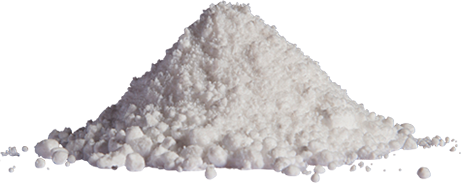FUMED SILICA
Overview:
Fumed silica (also known as pyrogenic silica and silicon dioxide) is one of the lightest substances known. Fumed silicas are very light and fluffy and have bulk densities of 3 lbs/cu ft (38 kg/cu m). Silicon metal and alloys are produced in electric furnaces. The raw materials include quartz, coal, and wood chips. The smoke that results from furnace operation is collected and sold as fumed silica. Depending on the processing, fumed silica may be used as a hydrophilic or a hydroponic.
From sidewalks and foundations to paint cans, printed pages and pet litter boxes, fumed silica's application as a universal thickening agent means it can be found in widely dissimilar places. Slightly abrasive and light-defusing, fumed silica is used in personal care products such as toothpaste and cosmetics.
Characteristics and Challenges:
Fumed silica powder has a high surface area. It is extremely fluffy and semi-free flowing and usually difficult to handle. The use of a fine-dust filter respirator by material handlers is recommended. Fumed silica is best kept as dry as possible. Once it is wet, fumed silica becomes very slimy and is extremely hard to handle as a heavy precipitate. Precautionary measures to prevent static discharges are also integral to the safe movement of fumed silica.
If the fumed silica arrives at the processing facility in bulk bags, the frames used to discharge the bags should be equipped with additional accessories designed to reduce the amount of manpower and effort necessary to transfer the fumed silica from the bulk bag into downstream equipment. These devices can elongate and stretch the bags, both from the top and bottom. This makes the bag rigid, which promotes a better flow and removes any pockets of fumed silica cornered in the bags. Some of these bag activating devices also serve as a dust tight seal between the bulk bag and the receiving hopper.

As the fumed silica from the connected bulk bag fills the receiving hopper beneath it, the air inside the hopper is forced out. Unless this air passes through a filter, airborne dust particles can escape into the surrounding atmosphere. A dust collector mounted on the discharger frame will contain the dust inside the conveyance system, lowering the risk of a potentially dangerous dusting. This same ventilation system can also be used to de-gas the empty bulk bags after the unloading of the fumed silica, completely deflating them and making the folding and storage or disposal of these bag a much cleaner operation. To suppress dust during the dumping and compacting of the bulk bags, a high-velocity fan drawing dust into cartridge filters is recommended. The filters can then be activated by an automatic reverse-pulse filter system returning the filtered dust into the receiving hopper and reducing waste.
If the fumed silica is packaged in smaller bags, a bag dumping station with a dust hood and filtration devices may be sufficient to support the manual unloading of the material in hoppers. A bag compactor connected to the dumping station will permit operators to pass empty bags directly to a compactor, creating a dust-contained disposal method for the empty bags. A hopper screen above the receiving vessel will help to prevent the introduction of foreign objects and protects the operators from potentially dangerous conveying equipment.
Standard capacitive level sensors, which are necessary to prevent a conveyor system from running after the feeding hopper has been completely emptied, may be ineffective with fumed silica. An evaluation of both the material and the system used to handle it is recommended. In some instances, vibrating forks and probes or rotating paddles are more reliable in sensing the levels of the fumed silica in the vessel and in alerting operators when levels are nearing full evacuation.
Flexicon Applications:
Flexicon designed a clean and safe way to introduce fumed silica into process vessels for a lubricant manufacturer. Handled incorrectly, the powder readily escapes as nuisance dust that will linger, suspended in the ambient atmosphere. Flexicon's Dust Suppression and Collection Systems ensure proper containment of fumed silica throughout the conveyance process.
Flexicon's product line of advanced flow promotion conveyors, high-flow hoppers, deaeration/densification decks and a host of other components and accessories are proven performers that promote flow while reducing degradation, dusting and/or the separation of blends comprised of disparate particles.
Flexicon's test lab will simulate your fumed silica handling applications before the system is installed in your plant.
Related Articles on Fumed Silica:
Sources: Where noted. All other information courtesy of Flexicon Corporation.